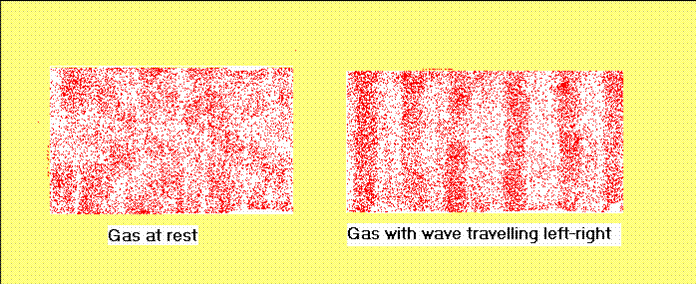Scientific Notation
- Format d.ddddx10n.
- d's called significant figures. We use about
3.
- Converting numbers >10
- Copy all the leading digits til reach
zeros
- Put new decimal point after first
digit.
- Write x10n where n is 1 less
than number of digits to left of original
decimal point.
- Eg. 1270000 = 1.27x106.
- Eg. 4.29x103 = 4290.
- Eg. 6.3756x102 = 637.56.
- Converting numbers <1
- Ignore leading zeros
- Copy rest of digits.
- Put new decimal point after first
digit.
- Write x10-n where n is 1 more
than number of zeros to right of original
decimal point.
- Eg. 0.0032 = 3.2x10-3.
- Eg. 7.23x10-8 =
0.0000000723.
- Often use prefix letters to show common
powers of 3.
- mega is x106 so eg.
12MW=12x106W=1.2x107W.
- kilo is x103 so eg.
0.57kW=0.57x103W=570W.
- milli is /1000 or x10-3 so
7mW=7x10-3W=0.007W.
- micro is x10-6 so
260mW=260x10-6W=0.00026W.
Sound
- Frequency: How many repetitions or cycles in
1 second.
- Unit Hertz. 1Hz = 1 cycle/second.
- Can hear about 20Hz-20,000Hz (20kHz) when
young and rather less as grow older.
- That corresponds to about 10 octaves.
- Compare piano that spans about 7+ octaves.
Mine runs from 22.5Hz (low A) to about
3kHz.
- Period is duration of repetition or cycle of
wave. Frequency = 1/Period.
What is a wave?
- A
disturbance
- that travels
through space
- without net motion of
any physical object.
- Most waves travel through a medium such
as air, water, or string and involve motions
of the medium. However EM waves and Gravity
waves propagate through a vacuum so not an
essential property!
What is a Sound Wave?
- A wave travelling through a physical medium
in which the disturbance is small changes in
pressure.
- The medium is most often air but most things
will work. Sound travels extremely well in
water, in metal, and even in bone.
- Sometimes useful to restrict to audible
range (20Hz-20kHz) but inaudible sounds are
still sound waves so should qualify as audible
sounds if really want to restrict.
What moves in a Sound Wave?
- Air molecules move backwards and forwards
making regions of locally high and low
pressure.
- If wave travels left to right _ then air
molecules move left-right-left _
- This is called a Longitudinal Wave.
- Contrast with a Transverse wave (eg.
Water)
- In transverse, if wave moves left to right _
then particles of medium move up/down _
Motion in a Sound Wave

How to create a Sound Wave?
- Any disturbance that sets air moving creates
a sound wave.
- Wave your hand (too slow to hear) or wing
(hear if humming bird or mosquito).
- Make a piece of metal vibrate (eg.
Bell).
- Move air rapidly as in explosion.
How long does sound last?
- Exactly as long as the disturbance that created it.
- Short disturbance -> transient sound.
- Prolonged disturbance -> steady sound.
- Periodic disturbance -> periodic sound.
- We make a special study of periodic sounds. These must last
several periods to be perceived as periodic but then are of
great interest because are pitched.
|